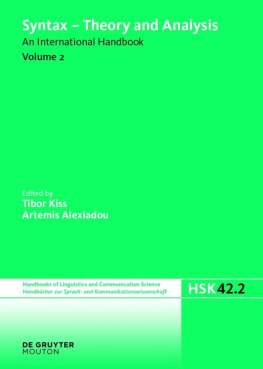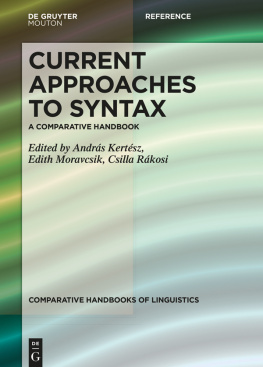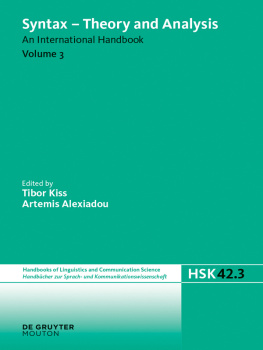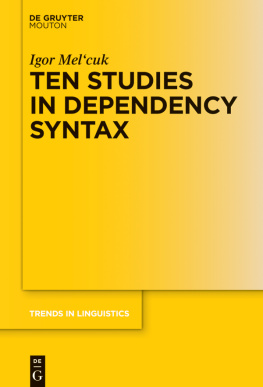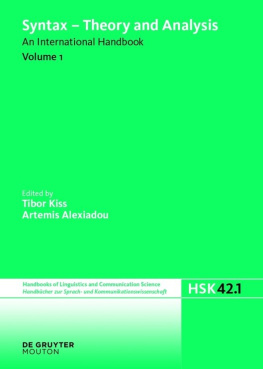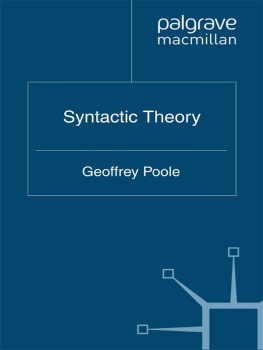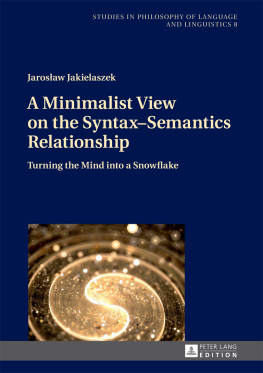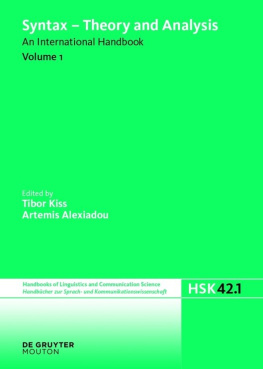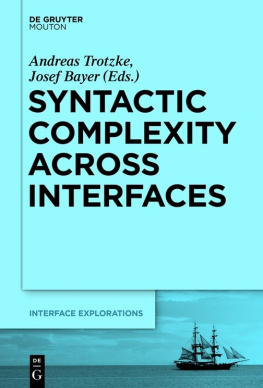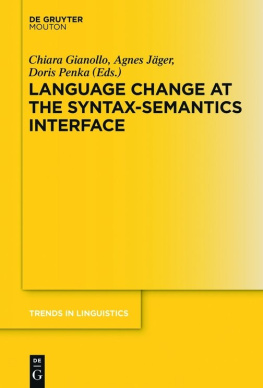24. Minimalism
This article offers an overview of some of the key concepts and developments of Chomskys Minimalist Program (Chomsky 1995), up to and including Chomsky (2008). Focussing on the conceptual underpinnings of the program, I examine in turn the three fundamental operations of Chomskys system: Merge, Agree (probe-goal), and Transfer (phases). For each of these, I highlight some of the ways in which minimalist principles, operations and interface conditions emerge from, replace, and above all simplify their GB antecedents, achieving greater explanatory depth, before also considering the empirical gains that they can afford. Some ongoing and unresolved issues and debates are also flagged up, illustrating the kinds of questions and concerns that characterize a minimalist approach to the study of language.
1. The nature of the program
Minimalism is a program for extending and developing linguistic theories beyond data coverage, holding them to a higher level of scrutiny and raising the bar for what counts as a genuine explanation of a linguistic phenomenon. Minimalist questions of the kind to be outlined below can be asked of any theoretical framework; the Minimalist Program (MP) itself, however, grew naturally out of the Principles and Parameters approach to transformational generative grammar (Chomsky 1981), and it is here that its greatest advances have been made and its most promising future prospects arguably lie. As the most recent incarnation of Principles and Parameters Theory (PPT), it shares with its predecessor, Government and Binding Theory (GB), the realist-mentalist conception of language fundamental to Chomskys work. That is, the object of study is I-language , a state of mind and a property of individual brains (I denoting internal, intensional, individual), and not language in its wider, social sense of a set of utterances or corpus of external tokens to which any individual has only partial access. The goal of rational linguistic inquiry is then to characterize the nature of that internal knowledge.
Traditionally, this characterization has sought to answer two questions: (i) What constitutes knowledge of language in the mind of a speaker-hearer (such that we have a correct description of the possible grammatical structures of a language)? And (ii) how does that knowledge arise in the mind of the speaker-hearer given the environmental stimulus (linguistic input) how is it acquired, how much of it is acquired, and what is a possible (acquirable) human language? Insofar as a theory can provide satisfactory answers to these questions, it meets the respective benchmarks of descriptive and explanatory adequacy. Doing so is no mean feat, since there is a clear tension between the two desiderata, i.e. between reconciling a sufficiently restrictive and universal theory of the initial state of Universal Grammar (UG) the genetic endowment which defines the range of possible, attainable human languages with the diversity of variation attested across the worlds languages. PPT offered the first real breakthrough in reconciling these antagonistic demands. By factoring out the universal (principles) from the variable (parameters), PPT simplified the acquisition procedure considerably instead of selecting among entire, fully specified grammars (as on earlier generative approaches), acquisition now proceeds by the fixing of values of a limited set of open parameters on the basis of salient input data. In this way, PPT solves Platos problem at least in principle (if not yet in practice).
The state of the field at the end of the eighties, then, could be roughly described as follows. A decade of research in GB theorizing had led to a richly specified view of UG as comprising a highly articulated modular architecture (Case Filter, Theta Criterion, X-bar Theory, Subjacency and the Empty Category Principle, Binding Theory, Control Theory, etc.), with each module composed of its own vocabulary, rules, conditions, constraints and principles. All of this technology was specific to UG, that is, to the faculty of language (FL), and it allowed for vast empirical coverage, thus attaining a high level of descriptive adequacy. Through parametrization of these principles under PPT, descriptive adequacy was attained for all possible human languages, as well as an account of their acquisition, thus reaching the level of explanatory adequacy. With GB thus yielding descriptive adequacy, and its umbrella framework PPT enabling explanatory adequacy, the stage was set for a deeper level of explanatory adequacy to be sought. That is, PPT was now in a unique position to seriously address minimalist concerns of the kind that had already been raised in the earliest days of generative grammar but which had been beyond the scope of feasible inquiry at that stage.
Essentially, minimalist concerns are those which relate to a third research question regarding the nature of linguistic knowledge (beyond questions [i] and [ii] above). If we are taking the biological foundations of FL seriously, then to the ontogenetic question in (ii), that of explanatory adequacy and the logical problem of language acquisition, must be added the phylogenetic question of how UG arose in the species. That is, we have to meet the desideratum of what we might call evolutionary adequacy (a term used independently by Longobardi 2004 and Fujita 2007; cf. the natural adequacy of Boeckx and Uriagereka 2007; and the coinage beyond explanatory adequacy of Chomsky 2004a) or Darwins problem (Boeckx 2009; Hornstein 2009) the logical problem of language evolution. Just as knowledge exceeds experience, demanding innate, language-specific mental structures in order to fill in the gap between linguistic input and the acquired final state of linguistic competence, so it seems that that knowledge (the richly specified UG of GB) exceeds what we can reasonably or plausibly attribute to natural selection, given the tiny evolutionary window within which human language is assumed to have appeared (suddenly, around 60,000 years ago; Chomsky 2008). The time frame is simply too short for a highly articulated, richly specified UG replete with myriad FL-SPECIFIC rules, constraints and principles to have emerged by selective pressure, with each piece of FL-specific technology (each rule, principle, module) separately selected for. Such a view is in any case implausible given that an FL containing, e.g., Principle A of the Binding Theory or a null-subject parameter would hardly be competitively fitter than one without. To the extent that FL accords a survival advantage, as it surely does, it does so as a whole, i.e. as a system for generating hierarchically structured sound-meaning pairs allowing thought, planning, evaluation and, ultimately perhaps, communication through externalization.
Every claim about the content of UG, then, is a claim about the brain; therefore, the more we attribute to UG, the greater becomes the problem of accounting for how it all got there, evolutionarily speaking. This problem simply cannot be ignored if we are taking seriously the claim that language (syntax) is a biological entity, a natural object to be investigated as part of the natural sciences. Unfettered proliferation of FL-specific technology ushers us ever further from a naturalistic approach to language and a genuine understanding of the properties of FL.
We thus have another tension between levels of adequacy to grapple with (descriptive/ explanatory versus evolutionary). In light of such considerations, the minimalist hypothesis is that UG must be maximally empty and maximally simple, perhaps containing just a single innovation that takes us from the pre-linguistic state to the fully functioning FL. A leading hypothesis, put forward by Hauser, Chomsky and Fitch (2002), is that this single innovation was (context-free) recursion, yielding phrase structure and providing a link between the two extralinguistic performance systems of sound (the articulatory-perceptual system, AP) and meaning (the conceptual-intentional system, CI). FL is thus reduced to its bare, conceptual minimum as a system for generating sound-meaning pairs. Clearly, a minimal UG leaves a lot of gaps to fill if we are to retain anything like the empirical coverage that the maximalist GB view of UG afforded. Minimalism attempts to fill those gaps by looking outside of FL itself to find general computational and cognitive rationalizations of the kind of FL-specific technology uncovered in GB studies, thus reducing that technology to the level of principled explanation . (On MP as a rationalization of GB, see also Hornstein 2001, 2009; Hornstein, Nunes and Grohmann 2005; Lasnik and Lohndal 2010.) The object of study thus shifts from data coverage (explaining judgements and intuitions) to the properties and principles of the language system itself, those identified under earlier PPT/GB models. The question to be answered is why the computational system of human language has these properties and not other ones, by finding principled explanations for these properties in terms of general factors nonspecific to the language faculty.

